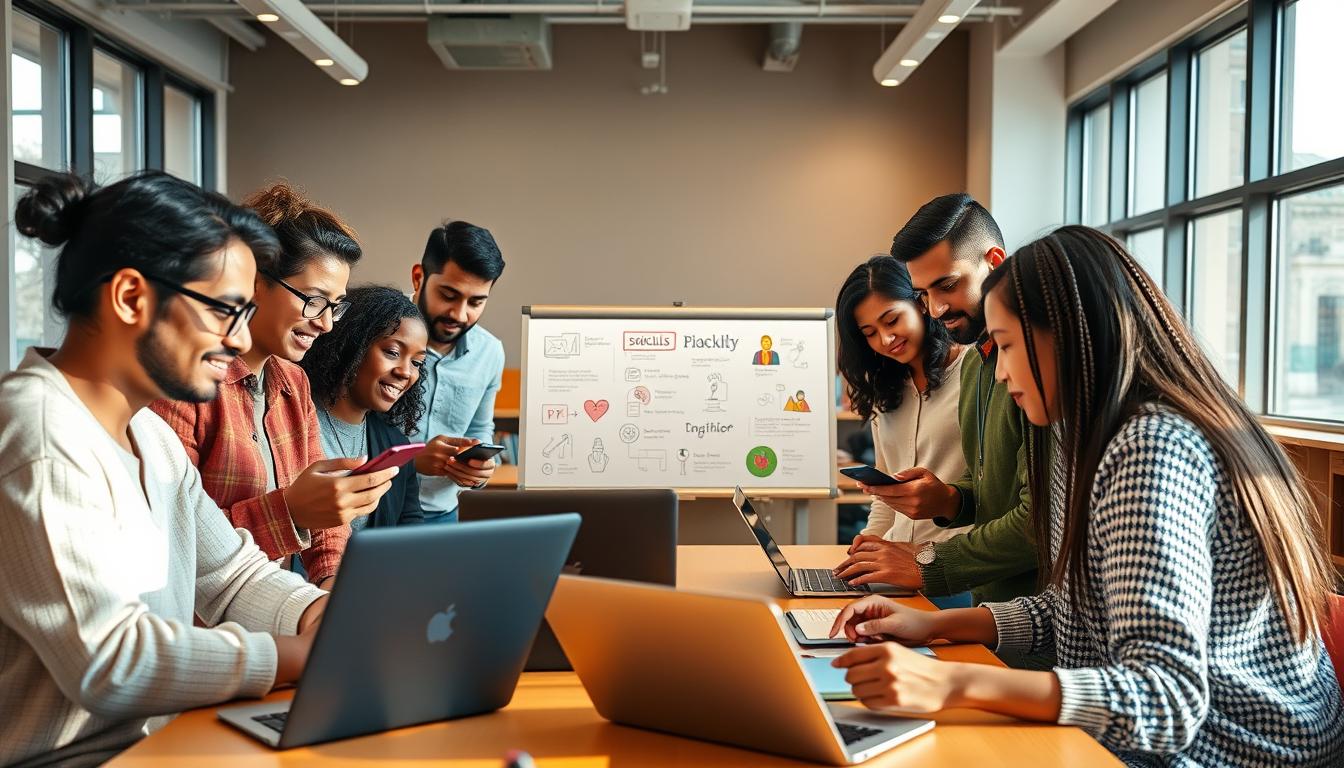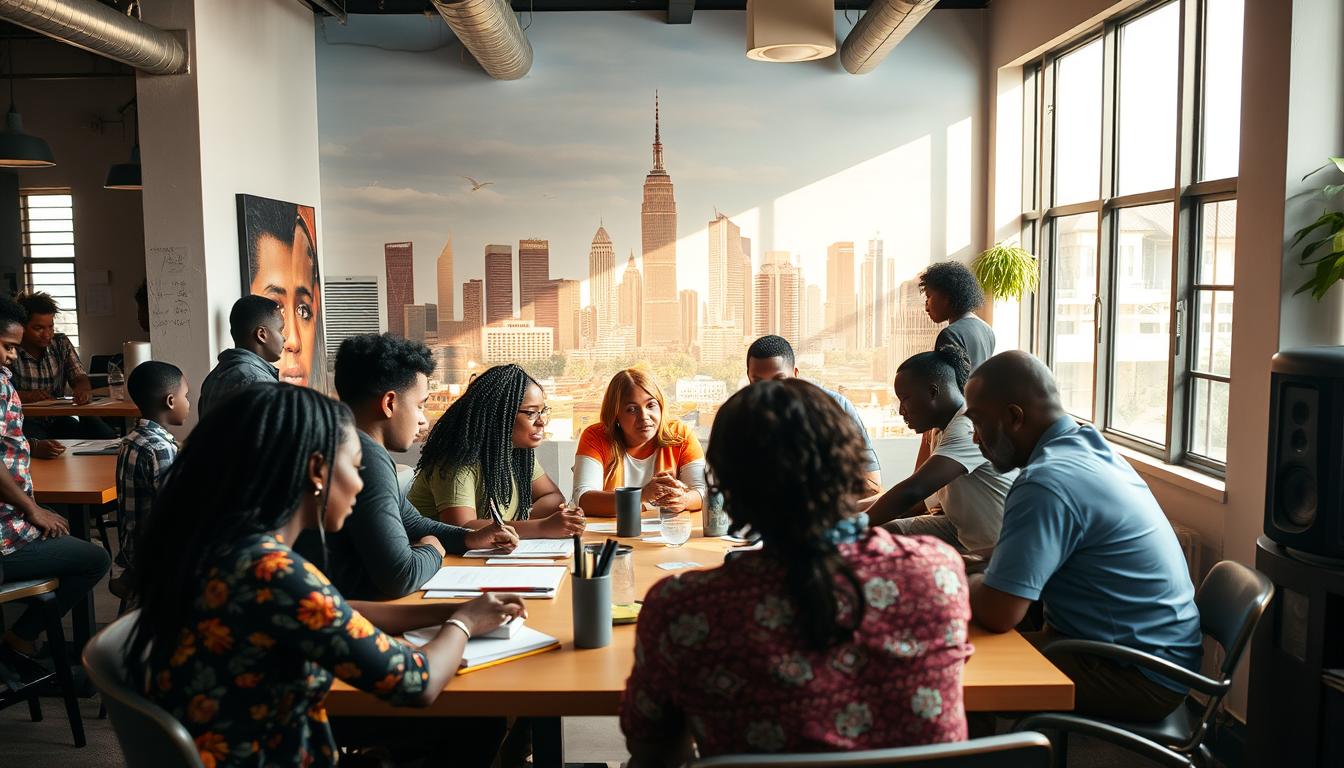Overcoming Language Barriers: Effective Communication Strategies for Non-Native Speakers
Language barriers can make communication tough, especially for those who are not native speakers. In Nigeria and other places, it’s key to find ways to talk across different cultures and languages. This helps in both personal and work relationships, and makes communities stronger.
Learning to get past language barriers is important. It helps make a place where everyone can join in and feel sure of themselves.
Introduction to Language Barriers
Language barriers are big hurdles in talking to each other, especially in places with many cultures. It’s key to understand these barriers to see the problems they cause for those who don’t speak the local language well. Good communication is vital for clear talks and strong bonds. In Nigeria, with its many cultures, these language issues get even more complicated.
What are Language Barriers?
Language barriers happen when people can’t talk to each other because of language differences. These issues range from simple mix-ups to big communication breakdowns. People who don’t speak the local language well often struggle to get their point across. This can cause frustration and confusion.
The Importance of Effective Communication
Good communication stops misunderstandings and makes places more welcoming. Being clear in what you say is crucial in diverse places. It lets people share their thoughts and ideas without worry of being misunderstood. Overcoming these communication hurdles helps build trust and teamwork, improving both personal and work relationships.
Language Barriers in Nigeria
Nigeria’s mix of cultures and languages is both rich and challenging for those who don’t speak the local tongue. With over 500 languages, the problem of language barriers is huge. Many face hard times in school and work because of these language issues. It’s important to tackle these barriers to improve communication and unity in this lively country.
Common Language Barriers Faced by Non-Native Speakers
Non-native speakers face many barriers to effective communication. These come from psychological, cultural, and technical language challenges. Knowing these issues helps us understand the hurdles of learning a new language.
Psychological Barriers
Psychological barriers are big in communication for non-native speakers. Many feel anxious and fear mistakes when speaking a new language. This fear can stop them from talking, missing chances to connect.
It’s key to overcome these barriers to build confidence and better communication skills.
Cultural Influences
Culture affects language, communication styles, and what we expect. Different cultural norms can cause misunderstandings, even among speakers of the same language. Non-native speakers might see phrases or gestures differently than others.
This shows why cultural awareness and sensitivity are vital for good communication.
Technical Language and Jargon
Technical terms and jargon make language harder. In work settings, they can leave non-native speakers out of discussions. Using simple language helps everyone contribute and feel included.
Factors Contributing to Language Barriers
Language barriers come from many factors that affect how well we can talk to each other. It’s important to know these factors to solve language problems in any place. Education, social status, and language resources are key.
Education and Literacy Levels
Education is key in learning languages. People with good education usually speak better. But, if someone can’t read well, talking becomes hard in daily life and work.
More education means better language skills for everyone. It helps communities speak more clearly.
Socioeconomic Influences
Money matters a lot in learning languages. Poor families often can’t afford extra language classes. This makes learning hard and keeps communication problems going.
We need to talk more about how money affects language learning. This way, everyone can get a fair chance to learn.
Access to Language Resources
Having books, classes, and tech is vital for learning languages. Places with lots of these resources help people learn better. Without them, learning is tough, and talking becomes hard.
Impact of Language Barriers on Communication
Language barriers greatly affect how we communicate, especially in diverse settings. They often cause cross-cultural miscommunication, leading to misunderstandings and conflicts. It’s crucial to recognize and address these differences to improve how we interact and work together.
Misunderstandings and Conflicts
When people don’t speak the same language or share the same culture, misunderstandings grow. A simple phrase can mean different things in different cultures, causing confusion or offense. In Nigeria, teams have faced miscommunications that block project success, showing how language barriers can be a big problem.
Emotional and Psychological Effects
Language barriers can deeply affect people’s emotions. They might feel isolated or frustrated, leading to lower self-esteem when they can’t express themselves. This can make people less willing to join in discussions or share their ideas, making groups and communities more divided. It’s important to understand these effects to create supportive environments where everyone can do well.
Challenges in Professional Settings
In multinational companies, language barriers pose big challenges for professional communication. Misunderstandings can cause mistakes in projects, affecting productivity and morale. To overcome these issues, training and support for employees are key. By improving understanding, we can make workplaces more inclusive and efficient.
Strategies to Overcome Language Barriers
Dealing with language barriers needs smart strategies. These help people who don’t speak the same language to talk better. Each method makes talking easier, helping to get past language differences.
Simplifying Language Use
Clear, simple language helps everyone understand. Staying away from hard words and sayings makes talking easier. This lets people talk without worrying about hard terms.
Encouraging Questions and Clarifications
It’s good to ask questions and get things clear. This makes talking better and helps people feel more confident. It makes sure everyone knows what’s going on, avoiding mistakes.
Using Visual Aids and Body Language
Using pictures, charts, and diagrams helps a lot. Adding positive body language makes things even clearer. This mix helps solve language problems and makes talking better.
Role of Technology in Bridging Language Gaps
Technology is key in overcoming language barriers for non-native speakers. It brings us tools that make communication across languages easier. These tools change how we talk to each other, making language differences less of a problem.
Language Translation Apps
Language apps are popular for their ease of use. Apps like Google Translate and Microsoft Translator help turn phrases into different languages. They help people in everyday talks, whether at home or abroad.
Online Language Learning Platforms
Online platforms help improve language skills. Sites like Duolingo and Babbel offer lessons for all levels. They use fun exercises and real-life examples to help learners grow their language skills.
Virtual Communication Tools
Virtual tools are crucial for working together from afar. Tools like Zoom and Skype make meetings possible across languages. They help share information easily, making teamwork and connections easier.
Importance of Cultural Competence
Cultural competence is key to better communication among different groups. It’s not just about knowing languages but also understanding cultural settings. By valuing and respecting various cultures, we can build stronger bonds and have more meaningful talks.
Understanding Cultural Context
Knowing the cultural background of language use helps avoid misunderstandings. Each culture has its own way of communicating, affecting how messages are sent and received. Understanding these differences leads to better communication and less conflict in cross-cultural talks.
Adapting Communication Styles
Being able to change communication styles is crucial for effective communication. This flexibility ensures messages connect with people from all walks of life. Adjusting how we communicate shows respect and helps in successful interactions.
Building Trust and Rapport
Building trust is vital for strong relationships, especially in diverse settings. Rapport helps people feel comfortable sharing openly. By grasping cultural norms, we create a space for collaboration and respect among different groups.
The Role of Education in Overcoming Language Barriers
Education is key in breaking down language barriers in diverse societies. Through language training, people can learn to communicate well. These programs offer structured help, making it easier to learn a new language.
Language Training Programs
Language training programs help non-native speakers communicate better. They include:
- Conversational practice and immersion techniques
- Customized curricula tailored to specific needs
- Support in industry-specific language acquisition
Integrating Language Learning in Schools
Teaching languages in schools gets kids ready for a world where many speak different languages. Learning a foreign language early on helps with adaptability and understanding different cultures. Schools can:
- Start foreign language classes early
- Organize language exchange programs with international partners
- Offer extracurricular activities that focus on language skills
Community Education Initiatives
Community programs are vital for language training outside of school. Local workshops and outreach programs help non-native speakers learn. These efforts include:
- Free workshops at community centers
- Partnerships with local NGOs to provide resources
- Cultural events that promote language usage
Encouraging Multilingualism
Promoting multilingualism is key to overcoming language barriers. Being able to speak more than one language brings many benefits. It helps in personal, professional, and cognitive areas. As the world gets smaller, knowing multiple languages becomes more important.
Benefits of Speaking Multiple Languages
Being multilingual has many perks. It boosts your brain, making you better at solving problems and thinking creatively. It also opens up more job opportunities, making you stand out in the job market.
In Nigeria, where many languages are spoken, being bilingual or multilingual helps a lot. It makes communication and teamwork better among different groups.
Promoting Language Exchange Programs
Language exchange programs are great for learning new languages and understanding cultures. They let you practice with native speakers, which is very helpful. You also make friends and connect with people from other cultures.
Supporting Bilingual Education
Bilingual education in schools is very important. It helps students grow in many ways, not just in school. It teaches them about different cultures, preparing them for a world where we all need to work together.
Case Studies of Successful Communication Strategies
Looking at real-life examples shows how different communication strategies work. These stories show how businesses, healthcare, and community programs have used new language solutions. They have made interactions better among people from different backgrounds.
Businesses and Language Solutions
Companies now see the value in language solutions to better connect with customers. A big retail chain in Nigeria put up signs in many languages and trained staff in local dialects. This made customers happier because they felt understood and included.
This example shows how good language strategies can help businesses grow.
Healthcare Settings and Patient Communication
In healthcare, clear and caring talk is key to good care. A hospital in Lagos started a program with interpreters for people who don’t speak the local language. This helped doctors talk better with patients and led to better health outcomes.
Many healthcare places have shown that language solutions improve trust and care.
Community Programs in Nigeria
Community programs in Nigeria have made a big difference by focusing on many languages. A project there had language workshops that helped people learn each other’s languages. This brought people together and made them appreciate each other’s cultures more.
These programs not only remove language barriers but also strengthen ties in diverse communities.
Resources for Non-Native Speakers
Non-native speakers in Nigeria have many resources to help with language barriers. There are tools for learning languages and community efforts for integration. These resources can improve communication and build connections among different groups.
Language Learning Materials
Effective language learning materials are key for mastering a new language. Non-native speakers can find:
- Textbooks made for non-native learners
- Online courses on grammar, vocabulary, and pronunciation
- Apps, podcasts, and videos that make learning fun
Support Communities and Organizations
Support groups offer vital help and motivation to non-native speakers. They create networks for those facing language challenges. These groups provide:
- Workshops to improve language skills
- Mentorship programs with fluent speakers
- Cultural events for interaction
Government and NGO Initiatives
Government programs and NGOs help reduce language barriers. They fund initiatives like:
- Language development programs
- Grants for bilingual education
- Collaborations between schools and language experts
Conclusion: Breaking Down Language Barriers
Exploring ways to overcome language barriers shows us a variety of strategies. Simplifying language, using visual aids, and encouraging questions are key. Technology and cultural understanding also play big roles in breaking down barriers.
The future of talking to each other depends on speaking many languages. As our world gets more diverse, we need to talk in a way that includes everyone. This helps us understand and get along with different cultures.
We need to take action to make communication more inclusive. Learning new languages is a big step. It helps us build a society where everyone can communicate freely.
FAQ
What are some common language barriers faced by non-native speakers?
How do socioeconomic factors contribute to language barriers?
What strategies can be employed to overcome language difficulties?
What role does technology play in bridging language gaps?
Why is cultural competence important in communication?
How can education help overcome language barriers?
What resources are available for non-native speakers seeking to improve their language skills?
Published on: 28 de March de 2025

Luke Martin
Luke Martin, author of Credwallets.com, is a mathematics graduate with a specialization in financial markets. Known for his love of pets and his passion for sharing knowledge, Luke created the site to provide valuable insights into the complexities of the financial world. His approachable style and dedication to helping others make informed financial decisions make his work accessible to all, whether they're new to finance or seasoned investors.







